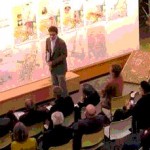 Back in the Dark Ages, we used to rely on overhead projectors to deliver our presentations.
Back in the Dark Ages, we used to rely on overhead projectors to deliver our presentations.
These bulky, electromechanical devices were pretty quirky, as their halogen lamps had a tendency to burn out during presentations, thus causing instant mumbling among the spectators. What with the projector failing and the audience moaning, the speaker’s anxiety levels would redline as things got from bad to worse.
In the large multinational company I used to work for, this up-and-coming executive had just launched into the final part of his upbeat pitch when the projector’s bulb popped dead. His boss became visibly embarrassed and asked him if he carried a spare bulb; to which the young executive shook his head no—the unspoken question “why should I” clearly painted on his face.
To compound the tragedy, no spare lamp could be located in the building and the presentation fizzled out.
Company lore had it that the up-and-coming executive’s career soon followed suit.
No, it wasn’t me. But it could have been.
Since then, I made sure I always had a spare bulb in my pocket when I approached that treacherous machine with my sheaf of transparencies. (This was before the dual-lamp projectors were introduced, an authentic quantum leap in Jurassic technology).
A few decades have gone by and we have gotten spoiled with sophisticated HD multimedia projectors, amazing presentation software such as PowerPoint, Keynote and, lately, Prezi.
Still, it pays to adopt a “belt-and-suspenders” approach. I always carry my own HD projector in the car trunk when I drive to a training venue (too bad I can’t when I fly or ride a subway there). This proved a very good idea one day, when the company that hosted my slide presentation had an impressive array of three ceiling-mounted projectors—none of which, however, would recognize my laptop.
My slide deck is always on my notebook’s desktop and on a thumb-drive, and if a total blackout occurs I can still talk my way out of a total disaster with the help of a flip-chart or whiteboard. And I always carry a set of USB-powered mini-speakers for my laptop. In my experience, the audio equipment one finds in conference venues can be sketchy, while my mini-speakers will work just fine with audiences up to 20 people.
Don’t let a technological breakdown sap your spirit and confidence. Always have a backup plan.
Steve Jobs used to collect and rehearse little anecdotes from Apple’s early days so he could entertain his audience while his backstage crew rushed to fix some technical glitch during one of his signature presentations. And he arguably had the best technology in the world at his disposal.
